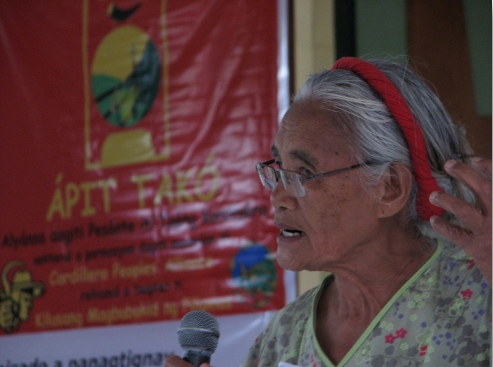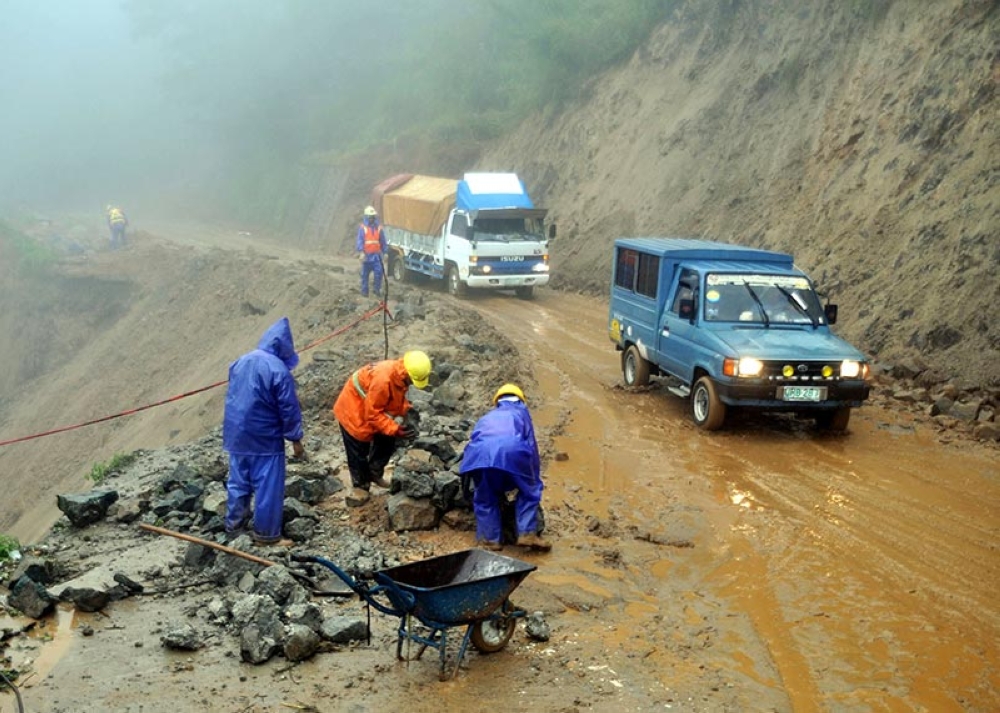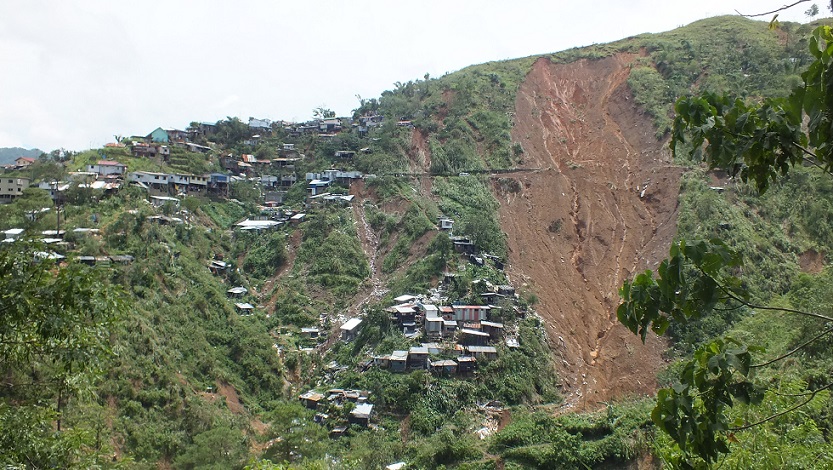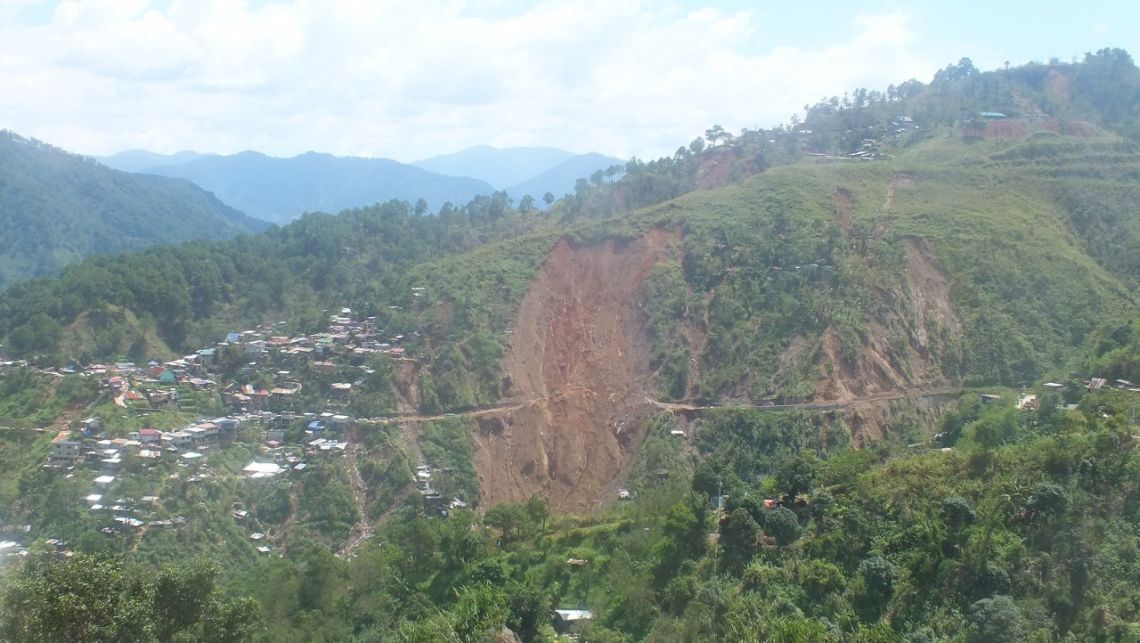
The eroded mountain which buried dozens at the Ucab mine site.
Ten months ago, a
powerful typhoon triggered a landslide that buried dozens of miners
and their families in Benguet province in the north.
Typhoon Ompong
(international name Mangkhut) barrelled through the highlands on Sept
15, 2018 and buried alive a community of small-scale miners who
sought refuge in a bunkhouse and makeshift church in Ucab, Itogon
town, not knowing it would be their grave.
Now that the
rainy season has started, the spectre of another disaster is
uppermost in people’s minds, and government agencies are preparing
so that residents could be moved to safer areas way before any harm
could get to them, says Itogon mayor Victor Palangdan.
Palangdan has
ordered the demolition of shanties in landslide prone areas so that
no one inhabits them and has asked the local disaster team to make
the rounds of communities living in no-build or danger zones to make
sure they heed evacuation warnings in the event that a typhoon hits.
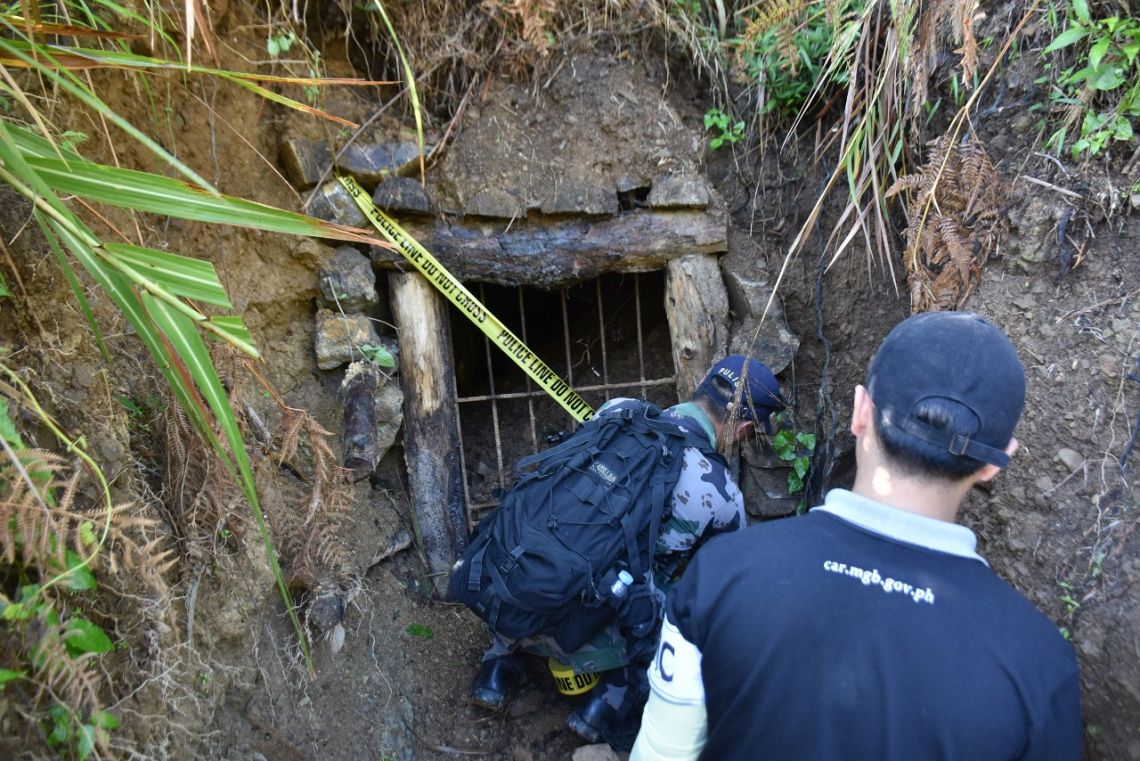
A member of a task force seals off the entrance to a mining tunnel in Itogon.
Shortly after
Ompong devastated Itogon, Department of Environment and Natural
Resources (DENR) Secretary Roy Cimatu ordered a stop to all
small-scale mining activities in the Cordillera Administrative
Region.
He deployed soldiers and police to enforce the cease and desist order, ignoring appeals by small miners that the government reconsider its decision because it would leave them without a source of livelihood.
Cimatu held a dialogue with over 4,000 small-scale miners from Benguet who were affected by the crackdown. The miners failed to have the order reversed but for a 30-day period, gold processing of stockpiles was allowed by the Provincial Mining Regulatory Board (PRMP), enabling at least 100 processors to cash in on their past hauls.
Typhoon Ompong and the subsequent mining ban, however, had an unintended consequence: it helped fast track the government’s processing of applications for Minahang Bayan (MB) areas in the Cordillera where unregulated mining is rampant.
Common mining areas for small-scale miners
The first MB application was approved in Itogon town last April and awarded to the Loacan Itogon Pocket Miners Association (LIPMA). It has yet to start operations.
“That is just one. There are more,” Mines and Geosciences Bureau (MGB) regional director Faye Apil said, referring to several other small-scale mining associations with over 10,000 members waiting to be awarded MB licenses.
A Minahang Bayan is a common area where small-scale miners are allowed to operate. It centralizes the processing of mineral output within a zone, helping curb illegal, unregulated and indiscriminate mining. It also allows the government to better monitor gold production by small-scale miners.
Under the rules, small scale miners can organize themselves into groups or cooperatives and apply for the establishment of common mining sites in their locality.
Renewed interest in these common mining sites followed the signing by former President Benigno Aquino III in 2012 of the New Mining Law Executive Order 79 containing mining regulations and designating 80 hectares for each registered group. There had been applications since then but not one was approved.
The MB site awarded to LIPMA is within the patented mineral claims of Benguet Corporation, which has endorsed the application. The site was also issued a certificate of non-overlap by the National Commission in Indigenous Peoples-Cordillera.
Director Apil said there are 54 applications for MB all over the region with the province of Benguet having the highest number with 18, followed by Apayao with 14, and Abra, seven. Baguio City has six, Mountain Province, five and Ifugao and Kalinga with two each.
She said nine applications from the province of Apayao alone have been forwarded to the office of Secretary Cimatu for approval. In the Mountain Province, a lone applicant in the tourist town of Sagada is working on its papers and clearances, while and one in Kalinga is in the process of completing the requirements.
Under the rules, the provincial or city mining regulatory board will first have to approve the site of a prospective community mining area, after which it will have to be evaluated and verified by the MGB central office and then endorsed to the DENR chief for clearance and approval.
Town living in fear
Fear of another tragedy is not the only problem facing Itogon. After Ompong, hundreds of families are still homeless.
Last year, Mayor Palangdan said, the National Housing Authority (NHA) awarded a total of P20 million for the purchase of a lot and construction materials for the resettlement of those displaced by the typhoon, the most powerful one that hit the country in 2018.
“We tried our very best. I created a task force resettlement to look for better resettlement for around 700 families but when we checked the lots at the MGB, it did not pass, it was high risk, or in a danger zone. That is why we are still looking.”
The mines bureau assessed the town and found that a mere 3.0 per cent of the area is safe for residents to live in, prompting Palangdan to ask for a reassessment of the entire municipality.
At least 10 hectares of land is needed to accommodate all the families that need to be relocated, the mayor said, adding that all those affected are now living with relatives, while others returned to hometowns through the “Balik Probinsiya” program of Department of Social Welfare and Development.
“The 700 families are still waiting for the relocation site. All of them are intact and are either renting homes or living with relatives at the moment,” said the mayor who won a fresh mandate in the May election.
With the onset of the typhoon season, the Office of Civil Defense-Cordillera is preparing to conduct an inspection of schools in high-risk areas, especially in Itogon.
Before classes opened last month, training was conducted by the Department of Education for schools located in risk clear areas which included, Ucab Elementary School, Ampucao Elementary and High School, Loacan, and Goldfield.
Without a relocation site, schools are forced to stay in these high-risk areas and told to be ready to suspend classes when the weather takes a turn for the worse.
The DepEd has also instructed teachers to conduct half-day classes to limit the number of pupils and not to utilize classrooms that have been condemned. The pupils are also being trained on disaster resilience and how to deal with flood, earthquake, and landslides.
Palangdan also wants to have a clear evacuation plan ready for the next storm as well as continuing monitoring of compliance to the ban on unregulated mining.
Apil said the MGB continues to monitor all tunnels that have been closed and assured they will remain shut while awaiting their permit for an MB.
Life after the mines
With the sudden halt in mining in the region, a way of life has forever changed for thousands who are still grappling to make a living outside the mines.
For 26- year- old Febralyn Dimas, daughter of a miner in Itogon who was rendered jobless when the closure order for the mines came, new opportunities have opened since.
Immediately after Ompong, the Dimas family stayed on the first floor of a neighbor’s five-story building in Baguio City with17 other families. This group received training on rug making as an alternative business to the erratic mining industry.
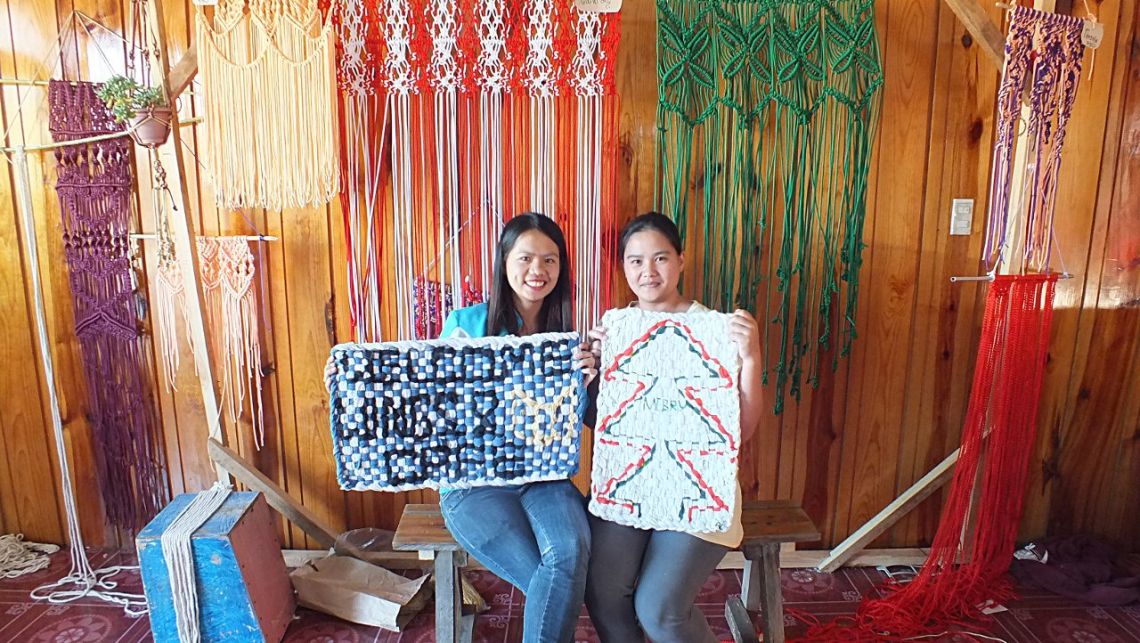
Making rugs and macrame wall hangings has become an alternative income source.
Today, Febralyn is part of a group of six who have chosen to continue making what are now dubbed as “resiliency rugs,” in reference to how the mine survivors have coped.
“We suspended production for a while because orders have stopped and we still have a lot of stocks. But we will produce once orders come in again and when old stocks are disposed of,” she said in Filipino.
The rugs made out of scrap cloth are sold at P60 a piece, with the carpets marketed at P6,699 and pot holders at P25. Macramé hangings range from P400 to P600.
Despite the temporary stop in production, Dimas and her team believe the rug-making business can become their main livelihood even when the mines reopen, saying any profit from mining will help strengthen the rug business.
For 28-year-old Kenneth Jones Pulsingay, a miner in Itogon, the days of closure had given him another livelihood that may tide him over until better days.
Wire crafted trees dubbed as “Ompong Trees” have become the main source of living for his family who had no recourse but to stop working when the mines were sealed.
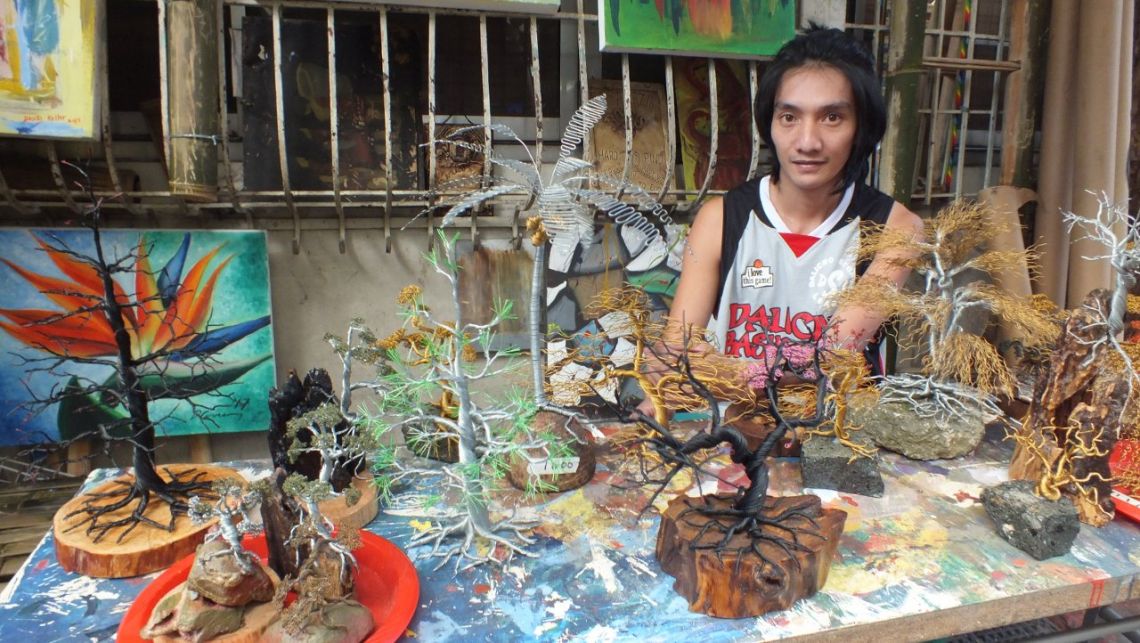
A past time turned into a lifeline for Kenneth Pulsingay.
The young father said he started to make wire toys for his son a few months before Ompong hit their province to pass the time, but when the tragedy struck, his pastime provided him a lifeline.
The “Ompong Trees” are being sold for as low as P150 to a high P2,500 per piece, depending on their size.
While the craft has provided Pulsingay some income, it is hoped there will be no more typhoons after which new wire toys will be named.
